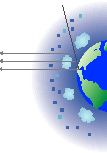
|
Atmospheric Sciences Data Centerprocessing, archiving, and distributing Earth science data at NASA Langley Research CenterRADIATION BUDGET • CLOUDS • AEROSOLS • TROPOSPHERIC CHEMISTRY |

|
Atmospheric Sciences Data Centerprocessing, archiving, and distributing Earth science data at NASA Langley Research CenterRADIATION BUDGET • CLOUDS • AEROSOLS • TROPOSPHERIC CHEMISTRY |
Hierarchical Data Format (HDF) is a data file format designed by the National Center for Supercomputing Applications (NCSA) to assist users in the storage and manipulation of scientific data across diverse operating systems and machines. NCSA developed a library of callable routines and a set of utility programs and tools for creating and using HDF files.
HDF supports a variety of data types: scientific data arrays, tables, and text annotations, as well as several types of raster images and their associated color palettes.
There are two distinct varieties of HDF, known as HDF (version 4 and earlier) and the newer HDF5. These are described in more detail at the NCSA HDF web site.
Some of the features of HDF are:
HDF files are also self-describing. For each data object in an HDF file, there are predefined tags that identify such information as the type of data, the amount of data, its dimensions, and its location in the file. The self-describing capability of HDF files has important implications for processing scientific data. It makes it possible to fully understand the structure and contents of a file just from the information stored in the file itself. A program that has been written to interpret certain tag types can scan a file containing those tag types and process the corresponding data. Self-description also means that many types of data can be bundled in an HDF file. For example, it is possible to accommodate symbolic, numerical, and graphical data in one HDF file.
For more information on what HDF can do, visit the HDF FAQ.
Or, view the slide presentation An Introduction to HDF.
HDF command line utilities are applications that allow you to perform common operations on and manipulations of HDF files. These utilities can be executed at the command level, like UNIX commands. The following are four examples of useful HDF command line utilities:
A comprehensive list of commands is available at the NCSA HDF Utilities page.
Tools to help you view and manipulate HDF data.
The HDF libraries and utility programs are available free of charge from NCSA via anonymous ftp from the sites listed below. Pre-compiled binary versions are available for a variety of computers and operating systems, or source code can be downloaded and compiled to build the software for a specific system.
Example of how to download and install the HDF Libraries.
HDF-EOS document list. This is a list of documents containing information about HDF-EOS, extensions to HDF that include three geolocated data structures defined as the standard for Earth Observing System (EOS) data products.
HDF-EOS Tools and Information Center.
NCSA HDF Home Page. Includes the latest news on HDF.
HDF Info - a commercial site with many links to HDF information. Includes utilities, a free HDF browser, and links to other sites that use HDF and similar data formats.